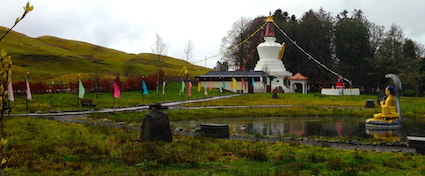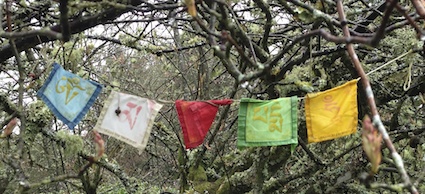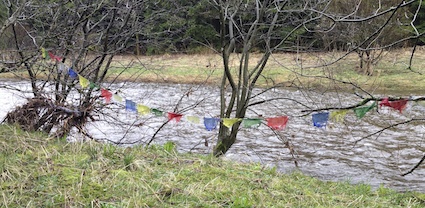As a Scottish primary teacher, I have to teach Religious and Moral Education which includes learning about other religions, not simply Christianity. Often people wonder how religious education can undertaken outdoors. It is easy to forget that the main world religions pre-date our obsession with indoor education by many centuries. Many religions and key religious texts have a deep appreciation of, and respect for, the natural world.

Several years ago, I visited the Kagyu Samye Ling Centre in Eskdalemuir. It is a Tibetan Buddhist Monastery and Centre for World Peace and Health – a remarkable place in all sorts of ways. I felt very privileged to be able to wander freely around the site and learn more about Buddhism.

One highly visual aspect of Buddhism is the presence of prayer flags which could be seen in many parts of the site. As you can see from the photos, there are different prayer flags but there are some consistencies between the types.

Firstly all prayer flags are “inscribed with auspicious symbols, invocations, prayers and mantras. Tibetan Buddhists have for centuries flown these flags outside their homes and places of spiritual practice for the wind to carry the blessing across the countryside. They are said to bring happiness, prosperity and long life to all beings.” In other words, the act of hanging up these flags is not simply for the person or his or her family’s benefit but for the greater wellbeing of everyone.

There are five colours of flags and each one symbolises a different element. There are five elements: earth – yellow; water – white; fire – red; air – green and space – blue. This is the order the flags are hung on string or ropes. When these elements are in balance there is health and harmony externally in the environment and internally within people.

By allowing the images and text on the prayer flags to fade through exposure to the elements, this ensures that the prayers become a permanent part of the universe. New flags are placed beside old ones. This is a way of renewing hope, welcoming the changes which happen in life and acceptance that all beings are part of a greater ongoing cycle.

The symbols and mantras on the prayer flags are sacred. They must be treated with traditional Tibetan respect. This means that they should not be placed on the ground or used in articles of clothing. The prayer flags should be left outside and allowed to disintegrate over time. If this is not possible then they should be disposed of by burning them.
For me, against the dark grey rainy skies, the prayer flags were a visual reminder of the positive presence of the Kagyu Samye Ling Centre, Buddhism and ways of living a little more simply and lightly on this planet.
For more information about prayer flags, then an online search should be useful. School groups are welcome to visit Samye Ling. In the words of one tour guide, Ani Jinpa, “Being able to come to Samye Ling really seems to bring Buddhism alive for many students who have struggled with it in class. Many also seem to have a keen appreciation for the benefits of mediation and a different perspective on emotions in their own life completely aside from Buddhism.“
Many thanks, again, to the Samye Ling community.
This post was originally published in April 2014.




















Hi any ideas for ‘outside the classroom’ learning for a primary school including early years for religious education.
Hi there. It depends what you are looking for. For Christian ideas have a look at Sue Thomson’s work on the Bible stories. https://tenbiblestories.org/contact/